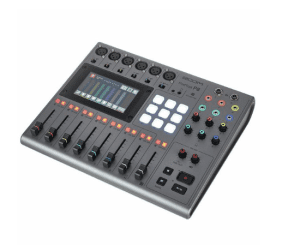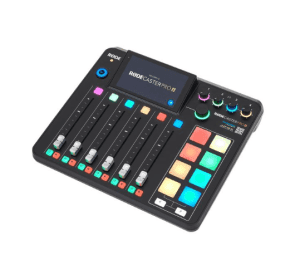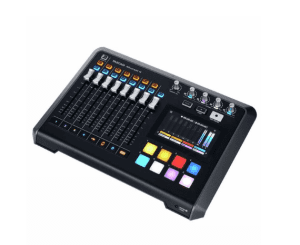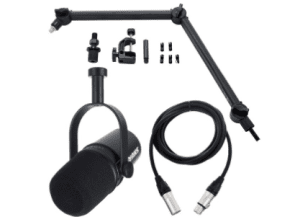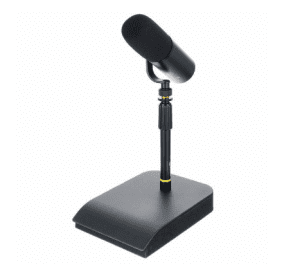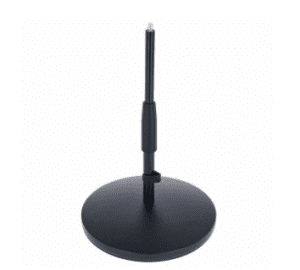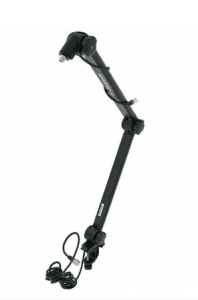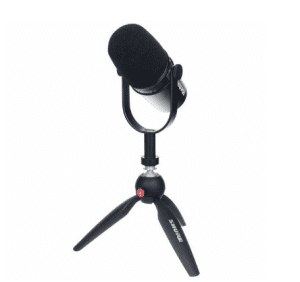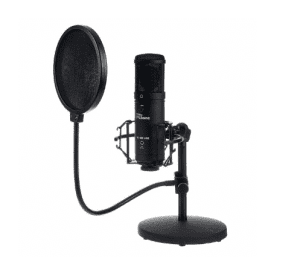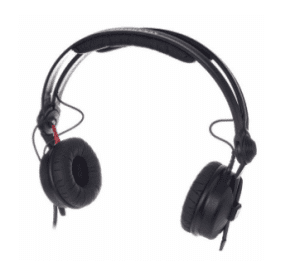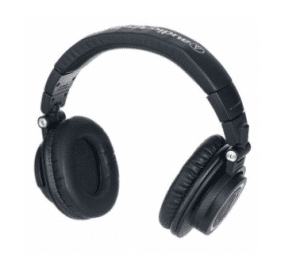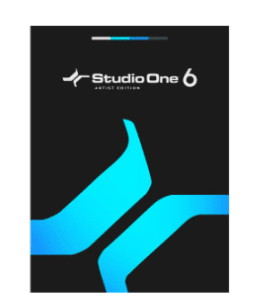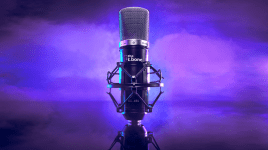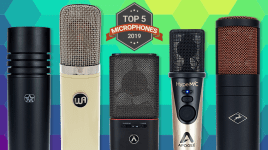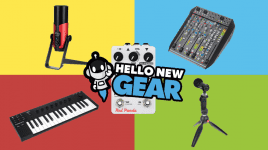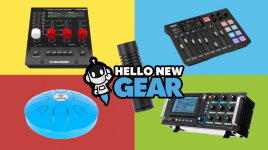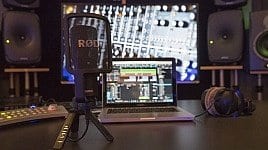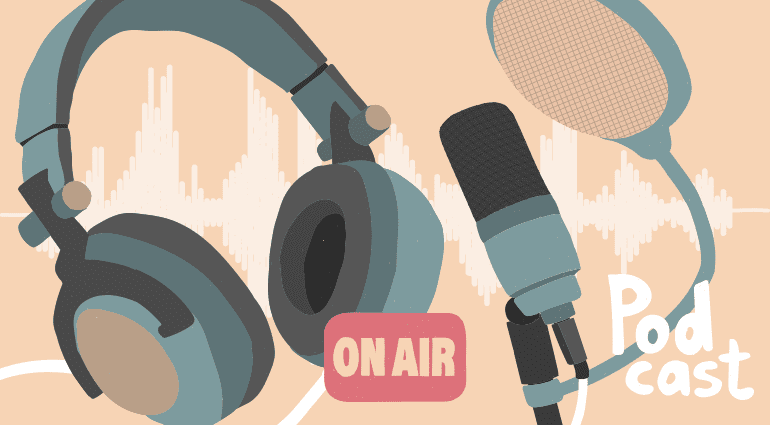
Creating your own podcast isn’t rocket science. However, it is not enough if you have good ideas and exciting content to offer: only the right technology enables you to produce a professional sound. These days you don’t have to spend a lot of money to get good results. With only a few purchases, a home podcast rig can be put together quickly – then you’re ready to go!
Compact Podcast Studios
A computer, or tablet, is the real heart of a small podcasting studio. But it is necessary to be able to record high-quality audio signals such as microphones. Unlike a regular audio interface, podcast compact studios are loaded with the features that make podcasting easy, enjoyable, and professional. There are mixer functions, special effects for speech and even your own recording options. You can often integrate very different signals from other computers or phones, and wirelessly. And last but not least, freely assignable pads ensure that you can fire off sound effects – from the typical applause reel to any self-made signature sound.
Some current devices with excellent features and a fair price are, for example, the Zoom Podtrak P8 and the Tascam Mixcast 4. From Rode, the Rodecaster Pro II is an excellent, very professional solution – and armed to the teeth with features!
- Rode Rodecaster Pro II 16
- Tascam Mixcast 4
Microphone
You can capture the voice with almost any microphone. However, there are special mics for voice recording – and a good voice sound right at the beginning of the chain is the most important part of a podcast! One of the best-known speaker microphones is the Shure SM7B. It is often used in broadcast. You will realize that your voice sounds assertive and “like radio” even without effects. Professionals also appreciate the fact that the SM7B is insensitive to pop noise and that the presences can be amplified with built-in filters.
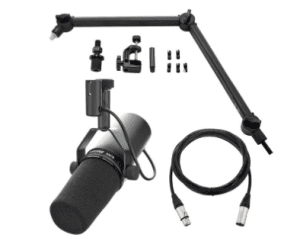
Shure SM 7 B Podcast Bundle
With the MV7X , Shure also offers a cheaper and simpler alternative to its classic.
Universal Audio, known for analog devices and audio interfaces, now also offers microphones. One is the Universal Audio SD-1 podcasting microphone. And you can buy a really inexpensive microphone, with a similar design: the t.bone BC 500.
Microphone arm / table stand
Microphones must not be hand-held while podcasting. Too much noise is usually transmitted. It is therefore necessary that you use a tripod or a microphone arm. One of the easiest and cheapest options is a simple table stand like the K&M 23320. With its round base, your mic will find a secure and stable place on the table.
The microphones mentioned are all boom microphones. They are meant to be operated overhead (although other positions also work). This has several direct advantages: There is room under the microphone to operate the keyboard, mouse, podcast compact studios and to place scripts. In addition, the microphone is usually further away from the tabletop, which is acoustically advantageous. And last but not least, the microphone can be easily adjusted to the seating position and also quickly turned away – for example to reveal the view on the screen if you want to edit your podcast.
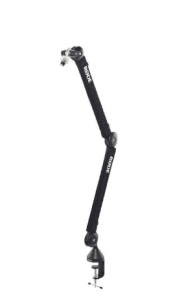
Mikrofonarm Mikrofonarm Rode PSA1+
Rode make an excellent table arm with the Rode PSA1+. This also holds heavy microphones, can be set up smoothly and comfortably and can hide the cables under a neoprene cover. Less expensive alternatives are the Millenium DS200 and the Roadworx Microphone Arm.
Alternative: USB microphone
A very simple and practical way to record your voice is something called a USB microphone. As the name suggests, such a microphone can be connected directly to computers via USB, and in many cases also to mobile devices. If a microphone is enough for you, this is an elegant and simple solution. You then regulate the details with the software. Shure has a USB version of the MV7X with a small tabletop tripod, the Shure MV7 Podcast Kit.
Many USB microphones have a condenser capsule instead of the dynamic capsule. It’s a bit more detailed, richer in depth and more sensitive. It is used in the Rode NT USB and Rode NT USB mini. And the t.bone SC 420 USB desktop set is a real bargain, but comes in a professional studio look with elastic suspension and pop protection.
- Rode NT USB+
- the t.bone SC 420 USB desktop set
Podcasting: Headphones for your studio
When you record something, you also have to be able to monitor it. Ideally, you should hear your microphone signal when speaking – because often it sounds different than you perceive it to be. Loudspeakers are not used for this purpose, they can be useful for later editing. However, closed headphones are important for podcasting. Closed because otherwise their sound might be captured by the mic.
The Sennheiser HD 25 plus is popular. These headphones have quite small, on-ear, cups and are also widely used by sound engineers, DJs and in the hi-fi sector. And the beyerdynamic DT-770 Pro and AKG K-371 are headphones with properties that are highly recommended for podcasts. The Audio-Technica ATH-M50 XBT2 is even Bluetooth-enabled!
Software
In order to professionally edit, mix and add the right effects to your podcast, you need an audio program. Almost all manufacturers of large digital audio workstations (“DAWs”) also offer slimmed down versions. These are significantly cheaper than the more extensive editions, but offer everything you need for podcasting. With Studio One 6 Artist, Presonus offers an excellent DAW for Mac and PC, and you can enter the world of Steinberg audio programs with Cubase Elements 12.
Questions & requests for advice on podcasting accessories
If you have any questions, our specialist advisors in the studio department will be happy to advise you without obligation:
Email: studio@thomann.de
Telephone: 09546-9223-30
You can make an appointment for a consultation using this link.
You are also welcome to come to our studio department in the shop in Treppendorf, near Burgebrach, Germany. Our team will then advise you personally.
Studio & Recording Equipment
Under this link you will find our entire product range in the areas of studio and recording. Have fun browsing and shopping!
With this equipment you can start immediately. We are looking forward to your podcasts, comment here and let’s hear them!
You are currently viewing a placeholder content from Facebook. To access the actual content, click the button below. Please note that doing so will share data with third-party providers.
More InformationYou are currently viewing a placeholder content from Instagram. To access the actual content, click the button below. Please note that doing so will share data with third-party providers.
More InformationYou are currently viewing a placeholder content from X. To access the actual content, click the button below. Please note that doing so will share data with third-party providers.
More Information